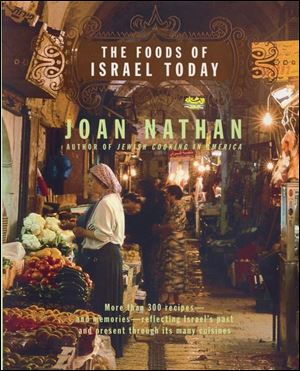
Passover feasts in many flavors
3/31/2001Foods for the Passover table can be as exotic as any ethnic cuisine in the world, or as traditional as favorite family recipes.
Whichever you prefer, The Foods of Israel Today, by Joan Nathan (Knopf, $40) offers food for thought and is a very good read.
I have been a fan of Ms. Nathan's since I first used her recipe for the traditional Purim sweet called hamantaschen in the 1980s. When I caught up with her in California for a phone interview while she was on a book tour, I asked about how Passover, which begins at sundown Saturday, will be celebrated in Israel.

Joan Nathan's cookbook explores different traditions.
“Many ways,” was her answer.
“Some of the people I know go to the desert and re-enact the Seder in a Bedouin village,” said Ms. Nathan, who lives in Washington. “Those who live in a kibbutz are likely to do planting following the Seder meal.”
“In cities, [the foods used to celebrate] depend on your ethnic background. For example, a woman from a German-Jewish family who married a man from a Moroccan family would add those customs to the celebration,” says Ms. Nathan. “There are side-by-side customs.”
Common to all celebrations is the Seder meal.
Lamb is among the symbolic foods which commemorate the Jewish Passover Feast. Family and friends join together for this eight-day festival, beginning with the Seder meal on the first two nights, to remember the exodus of Jews from slavery in Egypt.
From the book of Exodus, three foods are used to celebrate Passover: lamb, unleavened bread made with matzo flour and water, and bitter herbs. “It has been reinterpreted through the years,” said Ms. Nathan, the host and producer of PBS television's Jewish Cooking in America.
In the traditional Seder meal, the lamb shank bone symbolizes the Pascal lamb slaughtered for the blood used to mark the doors in Egypt so that the angel of death would pass over them. Unleavened bread, which is flat because it is made without yeast, serves as a reminder of the Jews' hurried departure from Egypt when there was no time to wait for the bread to rise. Bitter herbs or maror symbolize the hardships the Jews endured as slaves in Egypt.
For the Seder meal, individual customs emerge.
From her book, the Israel-inspired recipe Asparagus with Jaffa Orange and Ginger Vinaigrette is good for a Passover Seder meal. The Chocolate Mousse Cake made with matzo cake meal comes from a Polish Holocaust survivor. The popular Potato Pashtida is a Moroccan dish enjoyed by both Jewish and Arab Moroccans, which can be served at Passover.
“In any recipe that uses flour, use matzo meal,” she advises. Couscous is not served at Passover. Corn is avoided because it leavens or ferments. “A Syrian Jew or Moroccan Jew would use rice, but a German Jew would not,” she says. “Customs go back to their geographical origins.”
New products available in the United States labeled “Kosher for Passover” include some vegetable oils, vanilla extract, brown sugar, and confectioners' sugar (made without cornstarch).
“Passover is a time to do without processed or prepared foods. During Passover, I don't like to replicate my [daily] life. I won't use Passover pizza or Passover noodles. Why do you need pizza? It's a time to reflect Passover. It's a challenge.”
Still, she was contemplating her own Passover menu for 23 guests, including cookbook author Sheila Lukins (“She will bring tzimmes.”) and relatives from Israel as well as her own family.
Moroccan brisket with olives, tomatoes, onions, and preserved lemons will be the main dish served with the Israel-inspired Asparagus with Jaffa Orange. “I always serve strawberries,” she said. “And two kinds of haroset.” Haroset is the fruit-and-nut paste symbolic of mortar used when Jews were slaves in Egypt.
Her chicken soup with matzo balls is made with a family recipe. The soup is in the freezer, but the gefilte fish will be prepared on Friday morning. “I have it all figured out,” she said as she itemized her schedule.
Following the Seder meal and dinner, “we do a play with the kids. We have the baby Moses and the adult Moses. It's the best night of the year. It's also the hardest night of the year.
“You have to clean the house and remove all products with leavening. We have hard-boiled eggs in salt water, homemade gefilte fish, ceremonial foods such as the [lamb] shank bone and parsley.
“You are not allowed to cook on the Sabbath. Cooking should be done by sundown on Friday. That's complicated.”
Readers and cooks will enjoy the author's dedication to historical and Biblical connections as well as the joy of cooking found in The Foods of Israel Today.
In recognition of her work, Ms. Nathan will be among five inductees into the 2001 D'Artagnan Cervena Who's Who of Food & Beverage in America at the James Beard Foundation Awards April 30 in New York.
Israeli Revisionist Haroset
2 cups raisins
1 cup pecans, toasted
1 cup blanched almonds, toasted
1 cup date paste (or 1 cup dried dates, chopped)
3 Granny Smith apples, cored and cut into chunks
2 teaspoons cinnamon
1/4 cup sweet red wine, or to taste
1 to 2 tablespoons lemon juice
Using a food processor fitted with a steel blade, coarsely grind together the raisins and nuts, pulsing so as not to over-process. Add the date paste or chopped dates, apples, and the cinnamon and mix well. Add wine and lemon juice to taste.
Yield: 4 cups
Source: The Foods of Israel Today by Joan Nathan
Kathie Smith is The Blade's food editor. E-mail her at food@theblade.com.